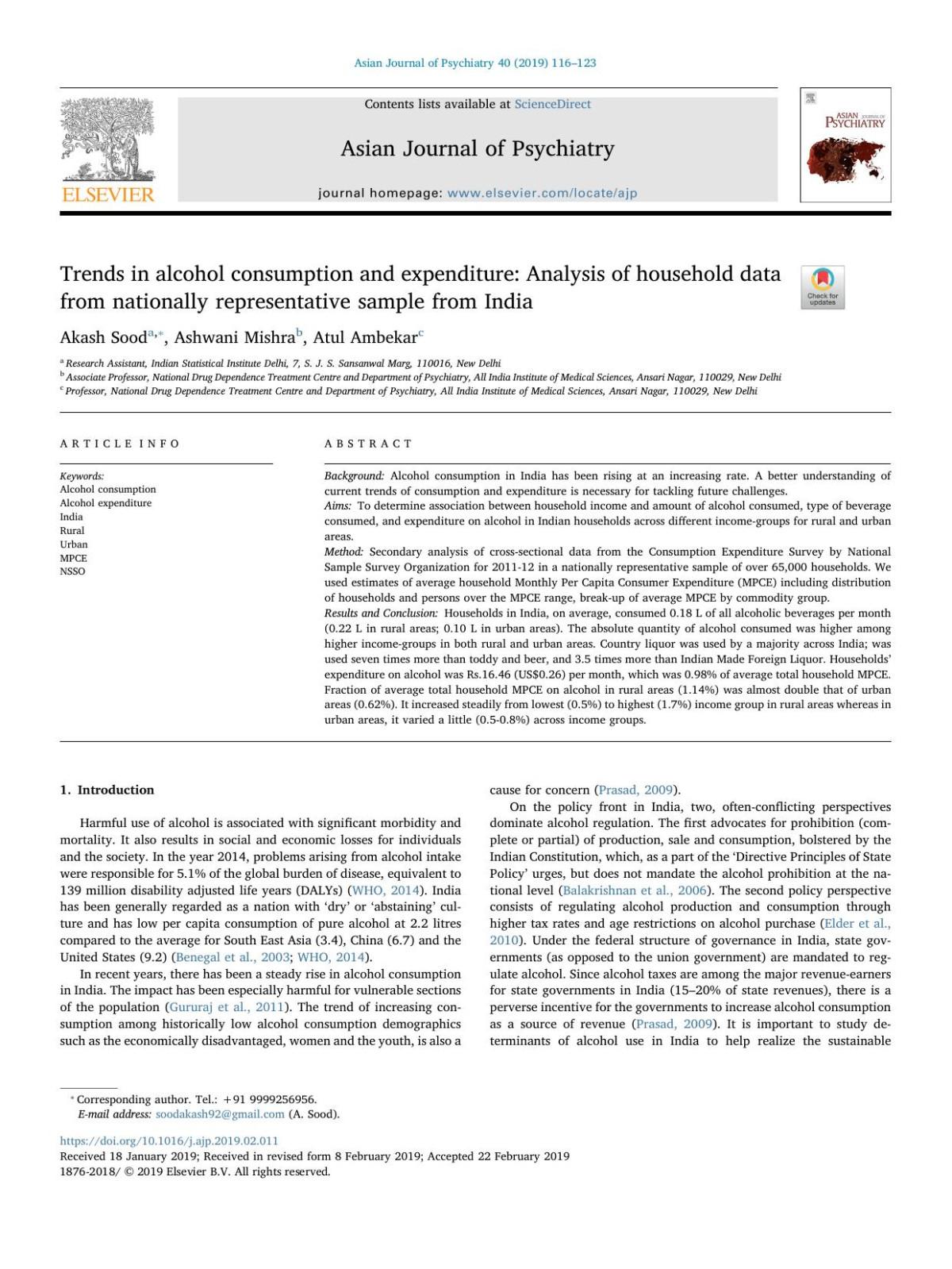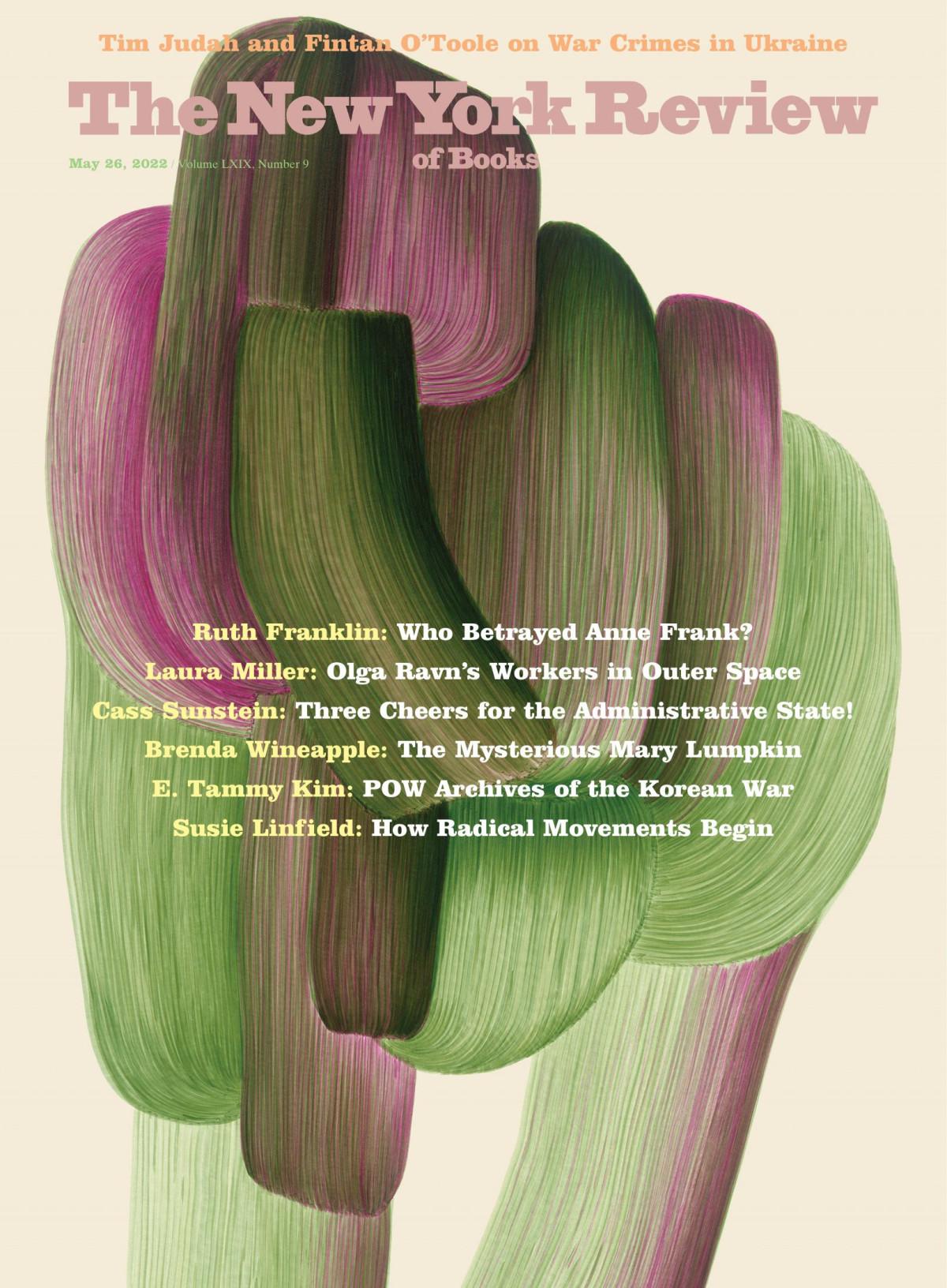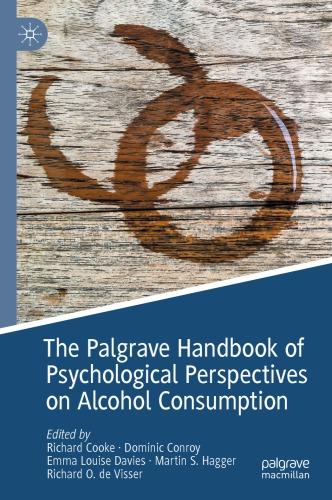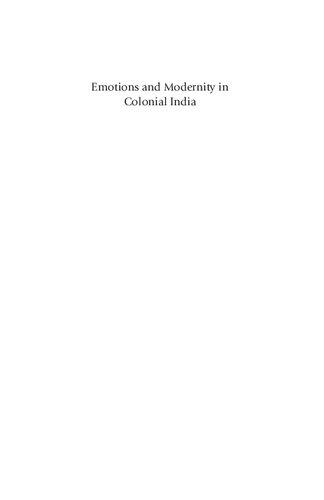Trends in alcohol consumption and expenditure_ Analysis of household data from nationally representative sample from India
Akash Sood & Ashwani Mishra & Atul Ambekar
https://ebookmass.com/product/trends-in-alcoholconsumption-and-expenditure_-analysis-ofhousehold-data-from-nationally-representativesample-from-india-akash-sood-ashwani-mishra-atulambekar/

Download more ebook from https://ebookmass.com
More products digital (pdf, epub, mobi) instant download maybe you interests ...

Elsevier Weekblad - Week 26 - 2022 Gebruiker
https://ebookmass.com/product/elsevier-weekbladweek-26-2022-gebruiker/

Intelligent Data Analysis: From Data Gathering to Data Comprehension Deepak Gupta
https://ebookmass.com/product/intelligent-data-analysis-fromdata-gathering-to-data-comprehension-deepak-gupta/

Jock Seeks Geek: The Holidates Series Book #26 Jill Brashear
https://ebookmass.com/product/jock-seeks-geek-the-holidatesseries-book-26-jill-brashear/

The New York Review of Books – N. 09, May 26 2022
Various Authors
https://ebookmass.com/product/the-new-york-review-ofbooks-n-09-may-26-2022-various-authors/

The Palgrave Handbook Of Psychological Perspectives On Alcohol Consumption 1st Edition Richard Cooke
https://ebookmass.com/product/the-palgrave-handbook-ofpsychological-perspectives-on-alcohol-consumption-1st-editionrichard-cooke/

From Cuffs to Christ: Freedom from Xanax, Alcohol, Depression, Anxiety, Fear, Abuse, Guilt, and the Pressure of Working in Corrections Kevin Zeiger
https://ebookmass.com/product/from-cuffs-to-christ-freedom-fromxanax-alcohol-depression-anxiety-fear-abuse-guilt-and-thepressure-of-working-in-corrections-kevin-zeiger/

Cyanobacteria: From Basic Science to Applications A. K. Mishra
https://ebookmass.com/product/cyanobacteria-from-basic-scienceto-applications-a-k-mishra/

Making Meritocracy: Lessons from China and India, from Antiquity to the Present Tarun Khanna
https://ebookmass.com/product/making-meritocracy-lessons-fromchina-and-india-from-antiquity-to-the-present-tarun-khanna/

Emotions and Modernity in Colonial India : From Balance to Fervor Margrit Pernau
https://ebookmass.com/product/emotions-and-modernity-in-colonialindia-from-balance-to-fervor-margrit-pernau/

AsianJournalofPsychiatry
journalhomepage: www.elsevier.com/locate/ajp
Trendsinalcoholconsumptionandexpenditure:Analysisofhouseholddata fromnationallyrepresentativesamplefromIndia
AkashSooda,⁎,AshwaniMishrab,AtulAmbekarc
a ResearchAssistant,IndianStatisticalInstituteDelhi,7,S.J.S.SansanwalMarg,110016,NewDelhi
b AssociateProfessor,NationalDrugDependenceTreatmentCentreandDepartmentofPsychiatry,AllIndiaInstituteofMedicalSciences,AnsariNagar,110029,NewDelhi
c Professor,NationalDrugDependenceTreatmentCentreandDepartmentofPsychiatry,AllIndiaInstituteofMedicalSciences,AnsariNagar,110029,NewDelhi
ARTICLEINFO
Keywords: Alcoholconsumption Alcoholexpenditure India


ABSTRACT
Background: AlcoholconsumptioninIndiahasbeenrisingatanincreasingrate.Abetterunderstandingof currenttrendsofconsumptionandexpenditureisnecessaryfortacklingfuturechallenges.
Aims: Todetermineassociationbetweenhouseholdincomeandamountofalcoholconsumed,typeofbeverage consumed,andexpenditureonalcoholinIndianhouseholdsacrossdifferentincome-groupsforruralandurban areas.
Method: Secondaryanalysisofcross-sectionaldatafromtheConsumptionExpenditureSurveybyNational SampleSurveyOrganizationfor2011-12inanationallyrepresentativesampleofover65,000households.We usedestimatesofaveragehouseholdMonthlyPerCapitaConsumerExpenditure(MPCE)includingdistribution ofhouseholdsandpersonsovertheMPCErange,break-upofaverageMPCEbycommoditygroup.
ResultsandConclusion: HouseholdsinIndia,onaverage,consumed0.18Lofallalcoholicbeveragespermonth (0.22Linruralareas;0.10Linurbanareas).Theabsolutequantityofalcoholconsumedwashigheramong higherincome-groupsinbothruralandurbanareas.CountryliquorwasusedbyamajorityacrossIndia;was usedseventimesmorethantoddyandbeer,and3.5timesmorethanIndianMadeForeignLiquor.Households’ expenditureonalcoholwasRs.16.46(US$0.26)permonth,whichwas0.98%ofaveragetotalhouseholdMPCE. FractionofaveragetotalhouseholdMPCEonalcoholinruralareas(1.14%)wasalmostdoublethatofurban areas(0.62%).Itincreasedsteadilyfromlowest(0.5%)tohighest(1.7%)incomegroupinruralareaswhereasin urbanareas,itvariedalittle(0.5-0.8%)acrossincomegroups.
1.Introduction
Harmfuluseofalcoholisassociatedwithsignificantmorbidityand mortality.Italsoresultsinsocialandeconomiclossesforindividuals andthesociety.Intheyear2014,problemsarisingfromalcoholintake wereresponsiblefor5.1%oftheglobalburdenofdisease,equivalentto 139milliondisabilityadjustedlifeyears(DALYs)(WHO,2014).India hasbeengenerallyregardedasanationwith ‘dry’ or ‘abstaining’ cultureandhaslowpercapitaconsumptionofpurealcoholat2.2litres comparedtotheaverageforSouthEastAsia(3.4),China(6.7)andthe UnitedStates(9.2)(Benegaletal.,2003; WHO,2014).
Inrecentyears,therehasbeenasteadyriseinalcoholconsumption inIndia.Theimpacthasbeenespeciallyharmfulforvulnerablesections ofthepopulation(Gururajetal.,2011).Thetrendofincreasingconsumptionamonghistoricallylowalcoholconsumptiondemographics suchastheeconomicallydisadvantaged,womenandtheyouth,isalsoa
⁎ Correspondingauthor.Tel.:+919999256956.
E-mailaddress: soodakash92@gmail.com (A.Sood).
https://doi.org/10.1016/j.ajp.2019.02.011
causeforconcern(Prasad,2009).
OnthepolicyfrontinIndia,two,often-conflictingperspectives dominatealcoholregulation.The firstadvocatesforprohibition(completeorpartial)ofproduction,saleandconsumption,bolsteredbythe IndianConstitution,which,asapartofthe ‘DirectivePrinciplesofState Policy’ urges,butdoesnotmandatethealcoholprohibitionatthenationallevel(Balakrishnanetal.,2006).Thesecondpolicyperspective consistsofregulatingalcoholproductionandconsumptionthrough highertaxratesandagerestrictionsonalcoholpurchase(Elderetal., 2010).UnderthefederalstructureofgovernanceinIndia,stategovernments(asopposedtotheuniongovernment)aremandatedtoregulatealcohol.Sincealcoholtaxesareamongthemajorrevenue-earners forstategovernmentsinIndia(15–20%ofstaterevenues),thereisa perverseincentiveforthegovernmentstoincreasealcoholconsumption asasourceofrevenue(Prasad,2009).ItisimportanttostudydeterminantsofalcoholuseinIndiatohelprealizethesustainable
Received18January2019;Receivedinrevisedform8February2019;Accepted22February2019
1876-2018/©2019ElsevierB.V.Allrightsreserved.
developmentgoalsoftheUnitedNations,SDG3.5thataimsto “strengthenpreventionandtreatmentofsubstanceabuse,including narcoticdrugabuseandharmfuluseofalcohol” (United Nations, 2014).
Relationshipbetweenalcoholconsumptionandeconomicstatusisa complexone.Fromdevelopedcountries,thereisarichliteratureonthe associationofeconomicstatuswithalcoholuse(KeyesandHasin, 2008).Indevelopingcountries,likeIndia,duetoapaucityofreliable data,suchanassociationhasnotbeenestablished.While,studiesexist whichhaveusedsmalllocalizeddatasetsfromdifferentpartsofthe countrylikeWestBengal(Chowdhuryetal.,2006),Punjab(Murthy, 2015),Mumbai(Narawaneetal.,1998)butassociationbetweenpatternsofalcoholconsumptionandeconomicstatushasnotemerged. Specifically,alinkbetweenthematerialstandardofliving(indicated bythehouseholdexpenditure)andalcoholconsumptionhasnotbeen wellquantifiedatanationallevel.Thestudyofthisrelationshipis importantfromtheperspectiveofalcoholtaxationpoliciessinceraising taxesisoftenrecommendedasapublichealthmeasuretoreduce consumption.
Inthisstudy,wesoughttocharacterizethehouseholdconsumption ofalcoholinIndia.Specifically,welookedattheamountofalcohol consumed,thebeveragewhichwasconsumed,andtheexpenditureon alcoholinanationallyrepresentativesampleofIndianhouseholdsbelongingtodifferentincomegroupsinruralandurbanpopulations.
2.Methods
Forthisstudyweanalysedthesecondarydata,alreadycollectedand availableinthepublicdomain.
2.1.Datasources
Thesourceofdataforthisanalysiswasthe68th roundofConsumer ExpenditureSurvey(CES)conductedbytheNationalSampleSurvey Organization(NSSO)in2011-12.Thisdatabaseisavailableinthe publicdomainandcanbeaccessedfreeofcostat http://mail.mospi. gov.in/index.php/catalog/145 .NSSOsurveysareconductedinyearly rounds(fromJune)infourwavesthroughouttheyear.Eachroundis classifiedasa ‘thick’ round,conductedonceevery fiveyears,or ‘thin’ , conductedinotheryears,dependingonthesamplesizeofhouseholds surveyed.ThethickCESisanationallyrepresentativesampleof householdsselectedrandomly.
The68th CESfollowedastratifiedtwo-stagesamplingdesignwhere the first-stageunitswerecensusvillagesintheruralareasandsampling frameblocksinurbanareas;thesecond-stageunitswerehouseholds.It coveredallthestatesandtheunionterritoriesofIndia,withthenationalsamplecomprisedofabout65,000households(eachhousehold definedasagroupofpeoplenormallylivingtogetherandtakingfood fromacommonkitchen).Forgatheringconsumerexpendituredata,a modifiedmixedrecallperiodwasused:(a)365-daysforclothing, footwear,education,institutionalmedicalcare,anddurablegoods,(b) 7-daysforedibleoil,egg, fishandmeat,vegetables,fruits,spices, beverages,refreshments,processedfood,pan(betelleaves),tobacco andintoxicants(includingalcohol),and(c)30-daysfortheremaining fooditems,fuelandlight,miscellaneousgoodsandservicesincluding non-institutionalmedical;rentsandtaxes.Monthlyvalueswerethen derivedfromthesevaluesusingappropriatealgebra(NSSO,2014).
2.2.Studyvariables
Baseduponthehouseholdincome,populationofthecountryhas beendividedintovariousincome-fractiles,indicatingdifferenteconomicclasses.Datareportedonamountandabsoluteexpenditureon differenttypesofalcoholicbeverages(describedlater)wasextractedto calculatepercentageofmonthlyincomespentonalcoholacrossdifferentincomefractilestoseevariationinconsumptionofalcohol.
2.2.1.Incomefractileclasses
In NSSO(2014)data,populationofthecountryhasbeendivided into12incomefractileclasses:0–5,5–10,10–20,20–30,30–40,40–50, 50–60,60–70,70–80,80–90,90–95and95-100.Anygivenfractile classcontainsinformationaboutpersonswhoseincomeisbetween lowerandupperpercentile.Thus,fractileclass10–20wouldinclude personshavingincomebetween10–20percentile;nthpercentilemeans thatn%ofpersonsarebelowthatvalue.Forexample,the0.05fractile isthe5st percentile,the0.5isthe50th fractile.
2.2.2.Averagehouseholdmonthlypercapitaconsumerexpenditure (MPCE)
AspertheCES,MPCEisdefinedastheaveragemonthlyconsumptionexpenditureofthehouseholddividedbythenumberof householdmembers(bothadultsandchildren).Thisdataisavailable foreverycommodity/itemonwhichtheexpenditurewasincurred.We usedtheMPCEonvariousalcoholicbeverages,separatelyforurbanand ruralareas.
2.2.3.Quantityandexpenditureondifferenttypesofalcohol
Dataonmonthlypercapitaquantityandvalueofconsumption(in Rs.)fortoddy,countryliquor,beerandforeign/refinedliquororwine, wasextractedandtabulated.
Alcoholicbeverageshavebeendividedinfourcategories: ‘toddy’ , ‘countryliquor’ , ‘beer’,and ‘Indianmadeforeignliquor-IMFL&Wine’ Toddy referstopalmwineandotherlowalcoholcontentbeverages producedlocally,usuallyinruralcommunities,usingtraditionaltechniques. Countryliquor isadistilledspiritusuallyderivedfromfermentationofmolasses(wasteproductfromsugarcaneindustry). Beer retains itscommoninternationaldefinitionofalowtomoderatealcoholcontentbeveragebrewedfromgrains(usuallybarley). IMFLorIndianmade ForeignLiquor referstodistilledspiritssuchasRum,Gin,Vodkaand Whisky,whicharemanufacturedandmarketedbylicensedIndian companies.ForthepurposeofCES,expenditureonIMFLisclubbed withdifferenttypesofwines.Thereisalsoa fifthcategoryconsistingof importedforeignliquor(IFL).UnlikeIMFLwhichismanufacturedin India,thesearedistilledspiritswhichareimporteddirectlytothe country.Importedforeignliquorisheavilytaxedasaluxurygood,and itsconsumptionislimited.Thus,thiscategoryhasnotbeenconsidered forthisanalysis.
Wecalculatedthetotalquantityandexpenditureonalcoholby summingupvaluesofeachtypeofalcoholicbeverage.Fractionof MPCEspentonagiventypeofbeveragewascalculatedbydividingthe expenditureonthattypeofbeveragebythetotalaverageMPCEofthe incomefractileclass.
2.3.Analysis
Theaggregatednatureoftheavailabledata(reportedasfrequency distributions)insteadofindividualdatapoints,precludesstandard methodsofstatisticalanalysisinvolvingregression.Hence,forthe cross-sectionalsecondaryanalysisinthisstudywefocusedonsummary statisticsofthedata.
Wetabulatedandthencalculatedpercentageofincomespenton fourtypesofalcoholicbeveragesacrossdifferentincomefractilesfor ruralandurbanareas.Karl-PearsonProduct-MomentCorrelation CoefficientwascomputedforaveragehouseholdMPCEandpercentage ofhouseholdMPCEspentonanalcoholicbeverageforeachofthefour beveragetypes,separatelyandalltogether,inruralandurbanareas.
WeusedStata14andMSExcel2016fordatahandling,statistical analysis,andpreparationoftablesand figures.
Table1
QuantityofAlcoholicbeverages(Toddy,CountryLiquor,Beer,IMFL,alltogether)Consumed(inLitres/month)forDifferentClassesofIncomeFractile;Nationally AveragedforRuralandUrbanareas.
Source:NSSO’s68throundCES(2011-12)data,*CLisCountryLiquor,**IMFLisIndianMadeForeignLiquor(includingWine). IncomeFractileQtyofToddyConsumed(L.)QtyofCL*Consumed(L.)QtyofBeerConsumed(L.)QtyofIMFL**Consumed(L.)QtyofTotalAlcoholConsumed (L.)
RuralUrbanRuralUrbanRuralUrbanRuralUrbanRuralUrban 0-50.030.010.050.050.000.000.000.000.070.07 5-100.060.010.070.070.000.000.000.010.130.10 10-200.030.010.080.050.000.000.000.010.110.08 20-300.060.020.070.050.000.010.000.010.130.09 30-400.100.010.110.060.010.010.010.010.230.09 40-500.090.010.080.040.010.010.010.020.180.07 50-600.080.010.110.040.010.020.010.020.210.08 60-700.100.010.100.060.010.030.010.030.220.11 70-800.160.010.100.030.010.040.020.020.300.10 80-900.180.000.100.030.030.040.040.040.340.10 90-950.120.000.120.030.020.070.060.050.310.14 95-1000.120.000.140.020.090.090.110.070.460.19 0-1000.090.010.090.040.010.020.020.020.220.10
3.Results
3.1.Quantityandtypeofalcohol
Thetotalconsumptionofallalcoholicbeverages(includingtoddy, countryliquor,beerandIMFL)inIndia,onanaverage,is0.22Linrural areasand0.10Linurbanareaspermonthperhousehold.Considering thatabout69%ofIndianpopulationisruralasperCensus2011 (Chandramouli,2011),thisshowsthatIndianhouseholdsconsumedan averageof0.18Lofalcoholicbeveragespermonthin2011-12.Interms ofspecifictypesofbeverages,overall,theIndianhouseholdsonan averageconsumed,permonth,0.07Loftoddy,0.07Lofcountryliquor, 0.01Lofbeer,and0.02LofIMFL.Whenfurtheranalysed,averagetotal quantityofmonthlyconsumptionoftoddy,countryliquor,beerand IMFLinruralareaswas0.09L,0.09L,0.01Land0.02Lrespectively whileitwas0.01L,0.04L,0.02L,0.02Lrespectivelyinurbanareas. Theabsoluteamountofallalcoholicbeveragesconsumedpermonth rangesfrom0.07Lforthelowestincomegroupto0.46Lforthehighest incomegroupinruralareas.Inurbanareas,thisrangeisbetween0.07L and0.19L.Ingeneral,agradientofhigheralcoholconsumptionwith higherincomelevelsisvisiblefromthedata(Table1).However,the highestincomegroupconsumesmorealcoholinruralareas(0.46L) comparedtourbanareas(0.19L).Further,quantityandtypeofalcoholicbeveragesacrossdifferentincomefractilesinruralandurban areasisdepictedin
3.2.MPCEontotalalcoholanddifferenttypeofalcoholicbeverages
Averagemonthlyhouseholdexpendituremadeonprocuringall typesofalcoholicbeveragesisRs.16.46[Rs.16.50(US$0.26),ruraland Rs.16.36(US$0.25)urban].Inruralareas,theMPCEonalcoholranges fromRs.3.25toRs.74.17inthelowesttothehighestincomefractile whereasinurbanareas,itrangesfromRs.3.84toRs.56.97.Intherural households,thefractionofMPCEontoddyrangesfromRs.0.56toRs. 3.15,oncountryliquorfromRs.2.73toRs.16.18,onbeerfromRs.0to Rs.8.54andonIMFLfromRs.0.07toRs.46.75.Intheurbanhouseholds,thefractionofMPCEontoddyrangesfromRs.0toRs.0.55,on countryliquorfromRs.3.20toRs.6.39,onbeerfromRs.0toRs.13.47 andonIMFLfromRs.0.36toRs.38.32.(Table2).Interestingly, Table2 alsoshowsthatuptotheincomefractileof60–70,theMPCEonalcohol isconsistentlyhigherintheurbanareas.Thetrendhoweverisreversed fromtheincomefractile70–80onwards,whereforallthehigherincomefractiles,ruralpopulationspendsmoreonalcoholthantheir urbancounterparts.
3.3.FractionofaveragetotalhouseholdMPCEonalcoholanddifferent typeofalcoholicbeverages
ThefractionofaveragetotalhouseholdMPCEspentontotalalcohol is0.98%oftheaveragetotalhouseholdMPCE(rural-1.14%andurban -0.62%)(Table3).Inruralareas,theMPCEonalcoholrangesfrom 0.5%to1.7%inthelowesttothehighestincomefractilewhereasin urbanareas,itrangesfrom0.5%to0.8%.Thispercentageforurban areasandruralareasisequalfortheincomefractilesin0-20th percentileandishigherinruralareasfortheincomefractilein30h-100th percentile.
Theoverallexpenditureonalltypesofalcoholicbeveragesasa fractionoftheMPCE,showsagradualbutdefiniteriseasincome fractileincreases,intheruralareas,whilesuchatrendisnotdiscernibleintheurbanareas(Fig.1). Fig.2 displaysthesametrendwith respecttodifferentalcoholicbeverages.Asevidentinthe Fig.2,witha riseinincome,theproportionalexpenditureonIMFLtendstobehigher whiletheexpenditureoncountryliquorandtoddytendstobelower.
3.4.Correlationbetweenhouseholdexpenditureandexpenditureonalcohol
Wedeterminedtheassociationbetweenaveragetotalhousehold MPCEandexpenditure(absolute)madeonalcohol,usingtheKarlPearsoncorrelationcoefficient,anditssignificancethroughthe t-test.A significantandnearlyperfectpositivecorrelationwasobtainedbetweenoverallMPCEandabsoluteamountofexpendituremadeonalcoholforbeer(r=0.97inruraland0.99inurbanareas)andIMFL (r=0.99inruraland1.00inurbanareas)(Tables4and5).Thus,when overallMPCErisesaswemovefromalowtoahighincomefractile,the absoluteamountofexpenditureonthesebeveragesrisesproportionatelyforbothruralandurbanareas.
Weconductedsimilaranalysisfortheassociationbetweenfraction ofMPCEmadeonalcoholandtheaveragetotalhouseholdMPCEusing theKarl-Pearsoncorrelationcoefficient,anddetermineitssignificance throughthe t-test(Tables6and7).Asignificantpositivecorrelation betweenaveragetotalhouseholdMPCEandpercentageoftheMPCE spentonalcoholforbeer(r=0.88inruraland0.59inurbanareas)and IMFL(r=0.94inruralandr=0.60inurbanareas)wasobtained. Thus,whenoverallMPCErises,thefractionofMPCEspentonthese beveragesalsorises.Thisriseismuchmoreprominentforruralareas comparedtourbanareas.ThehighercoefficientsforruralareasindicatesthatabsoluteexpenditureonbeerandIMFLrisesatamuch fasterratethantheoverallMPCEinruralareascomparedtourban areas.
Conversely,thereisasignificantnegativecorrelationbetweenthe
Table2
MonthlyPerCapitaExpenditure(MPCE)ondifferentalcoholicbeverages(Toddy,CountryLiquor,Beer,IMFL,alltogether)fordifferentclassesofincomefractile; nationallyaveragedforruralandurbanareas.
Source:Authors’ analysisofNSSOdata.
Income Fractile Avg.HouseholdMPCE(Rs.)MPCEonToddy(Rs.)MPCEonCL(Rs.)MPCEonBeer(Rs.)MPCEonIMFL(Rs.)MPCEonAllAlcohol(Rs.) RuralUrban RuralUrbanRuralUrbanRuralUrbanRuralUrbanRuralUrban 0-5650 712 0.460.212.733.200.000.070.070.363.25 3.84 5-10673 906 1.280.362.893.900.000.450.341.634.51 6.34 10-20795 1132 0.560.343.743.850.080.450.722.385.09
60-701431 2554 1.430.268.446.391.293.325.019.4516.1719.41
70-801649 3069 2.640.317.423.991.654.307.929.8219.7918.72
80-902014 3893 2.420.009.473.503.025.0612.8913.6327.7922.19 90-952564 5364 2.050.0010.514.832.058.0522.3118.7736.9231.65
95-1004495 103583.150.0016.185.188.5413.4746.7538.3274.1756.97 0-1001447 2639 1.590.006.664.491.302.906.808.4416.5016.36
overallMPCEandpercentageoftheMPCEspentonalcoholfortoddy (r=-0.65)andcountryliquor(r=-0.77),inurbanareas.Therefore, whenoverallMPCErises,thefractionofMPCEonthesebeverages decreases.Inruralareas,toddy(r=-0.31)hasasignificantnegative correlationbutcountryliquor(r=0.52)hasasignificantpositive correlation.Thus,fractionofMPCEontoddyconsumptioninrural areasdecreasesasincomeincreaseswhereasthefractionofMPCEon countryliquorincreaseswithriseinincome,similartothecaseofbeer andIMFL.
4.Discussion
Inthisstudy,anationallyrepresentativedatasetwasusedtocharacterizepatternofalcoholconsumptionandexpenditureinIndia.The consumptionwasmeasuredbyquantityofalcoholconsumedby households,typeofalcoholconsumed,overallmonthlyexpenditure madeonprocuringalcoholicbeveragesandexpenditureonalcoholasa fractionoftheaverageMPCEforvariousincomegroupsinruraland urbanareas.
4.1.Quantityofalcoholconsumed
Indianhouseholds(typicallywithanaverageof4.8numberof members,includingallagesandgenders)onanaverage,consumed
Table3
0.18L(rural – 0.22;urban – 0.10)ofallalcoholicbeveragespermonth in2012.Itmustbenotedthatthe figuresfor individualswhodrink,may besubstantiallydifferent.TherecordedpercapitaconsumptionofalcoholofpurealcoholinIndiahasbeenreportedtobe2.2L(WHO, 2014).InanepidemiologicalstudyfromUSA,alcoholusewasfoundto behigheramongstindividualswiththehighestfamilyincomeas comparedtothosewithlowerfamilyincomes(Grant,1997).Interestingly,inmanystudiesfromIndia,alcoholusehasbeenfoundtobe higheramongpeoplefromlowereconomicclasses(Neufeldetal.,2005; Subramanianetal.,2005; Sugathanetal.,2008; Tomaretal.,2016). Notably,suchstudiestendtofocusuponproblemalcoholuse(like abuse,hazardoususeordependence),whereasourdataset,provided informationonthequantityandexpenditureonalcoholoverthepreceding7days.
4.2.Typeofalcoholconsumed
Apartfromthetotalamountofalcoholconsumed,dataontypeof alcoholprovidedinterestinginsights.Countryliquorappearedtobethe drinkofchoiceforamajorityevidentbyitsusebeingseventimesmore thantoddyandbeer,and3.5timesmorethanIMFL.This findingisin linewithreportsthat94%ofalcoholicconsumptioninIndiaisinthe formofspirits-countryliquorandIMFL(Girishetal.,2010; Gupta etal.,2003; WHO,2014).Indiaalsoscoreshigherthanmostofthe
FractionofHouseholdMonthlyPerCapitaExpenditure(MPCE)spentondifferentAlcoholicBeverages(Toddy,CountryLiquor,Beer,IMFL,alltogether)fordifferent ClassesofIncomeFractile;NationallyAveragedforRuralandUrbanareas.
Source:Authors’ analysisofNSSOdata,FractionofhouseholdMPCEonaparticularbeverageiscalculatedasexpenditureonthatbeveragedividedbyavg. MPCE*100foraparticularincomefractileinruralorurbanarea.
Income Fractile Avg.HouseholdMPCE (Rs.)
Fraction*ofMPCESpent onToddy(%)
FractionofMPCESpent onCL(%)
FractionofMPCESpenton Beer(%)
FractionofMPCESpenton IMFL(%)
FractionofMPCEonAll Alcohol(%)
RuralUrbanRuralUrbanRuralUrbanRuralUrbanRuralUrbanRuralUrban 0-56507120.070.030.420.450.000.010.010.050.500.54 5-106739060.190.040.430.430.000.050.050.180.670.70 10-2079511320.070.030.470.340.010.040.090.210.640.62 20-3090613630.100.040.460.350.020.110.080.290.660.79 30-40105416300.150.020.530.390.040.070.150.290.860.76 40-50114218940.120.010.510.180.050.080.220.330.900.60 50-60128321900.100.010.500.180.040.090.190.250.830.54 60-70143125540.100.010.590.250.090.130.350.371.130.76 70-80164930690.160.010.450.130.100.140.480.321.200.61 80-90201438930.120.000.470.090.150.130.640.351.380.57 90-95256453640.080.000.410.090.080.150.870.351.440.59 95-1004495103580.070.000.360.050.190.131.040.371.650.55 0-100144726390.110.000.460.170.090.110.470.321.140.62
Fig.1. VariationinPercentageofHouseholdMPCEspentonAllAlcoholicBeverageswithchangeinHouseholdIncomeFractileforRuralandUrbanareasatthe Nationallevel.
developedworldontheWHO’sPatternsofDrinkingScorewhich measuresriskinessofthepatternofdrinking.Thepreferenceforhigh alcoholconcentrationdrinkscanbeattributedtothetendencyofIndiansto ‘drinktogetdrunk’.(PHFI,2013; WHO,2014)Whileanalysing therelationshipbetweentypeofalcoholconsumptionandincome,it wasfoundthattoddyconsumptionacrossallincomegroupswaslimited toruralareas.Forlowandmiddle-incomegroupsinruralareas,toddy andcountryliquorwerethemostconsumedbeverages.Astheincome grouprises,theconsumptionoftoddyandcountryliquorremainsthe same,butthereisasteadyincreaseinconsumptionofbeerandIMFL.In urbanareas,countryliquoristhedrinkofchoiceforlowerincome groupsanditsconsumptionremainshighevenforhigherincome groups.ThereisasteadyincreaseinconsumptionofbeerandIMFL withincreaseinincome. Rahman,(2003) foundthatruralhouseholds significantlyprefertoddytoIMFLandbeercomparedtourbanhouseholds.TheyalsofoundhigherincomeelasticitiesforIMFLandbeer comparedtotoddyandarrack,i.e.,theconsumptionofformerrises fasterwithincreasingincome.
4.3.Expenditureontotalalcoholanddifferenttypesofalcoholicbeverages
Indianhouseholdsspentaboutonepercentoftheaveragetotal householdMPCEonalcohol.Therewasanincreaseinexpenditureon alcoholwithrisingincomeinbothurbanandruralareasforallalcoholicbeverages.However,averagemonthlyexpenditureincreased steadilyinruralareas,whereasinurbanareas,itwasthesameacross incomegroups.
Forruralareas,thesteadyincreaseinfractionofaveragetotal householdMPCEspentonalcohol,aswemovefromlowesttohighest incomegroups,seemstobedrivenbyanincreaseinconsumptionof beerandIMFL,alongwithsubstitutionawayfromtoddyandcountry liquor.Thiscanbeexplainedbytheconceptofluxuryandnormalgood ineconomics.Foraluxurygoodthedemandincreasesmoreproportionallythanincome,incontrasttoanormalgood,whosedemand increaseslessproportionallythanincome(Varian,1992).Agoodperceivedtobeinherentlyhigherqualityisusuallyclassifiedasa ‘luxury good’ andalowerqualitygoodisclassifiedasa ‘normalgood’.The factorsthatmakeacertaingoodsuperiororinferiorvarywidelyacross countries.Inmostcountries,domesticallymanufacturedalcohol
Fig.2. VariationinPercentageofHouseholdMPCEspenton(a)IMFL,(b)Beer,(c)CountryLiquorand(d)ToddywithIncreasingHouseholdIncomePercentile;for UrbanandRuralareasattheNationallevel.
Table4
CorrelationofNationallyAveragedHouseholdMPCEandExpenditureondifferentAlcoholicbeveragesinRuralareas.
*Allvaluesaresignificantfor1%confidencelevelduetotheverylargesizeofsample(n=65,000).
Table5
CorrelationofNationallyAveragedHouseholdMPCEandExpenditureonDifferentAlcoholicBeveragesinUrbanareas.
Avg.HouseholdMPCE(Rs.) 1.00
ExpenditureonToddy(Rs.) 0.65*1.00
ExpenditureonCL(Rs.) 0.20*0.02*1.00 ExpenditureonBeer(Rs.) 0.99* 0.66*0.22*1.00
Allvaluesaresignificantfor1%confidencelevelduetotheverylargesizeofsample(n=65,000).
Table6
CorrelationofNationallyAveragedHouseholdMPCEandFractionofMPCEspentondifferentAlcoholicBeveragesinRuralareas.
Avg.HouseholdMPCE(Rs.) 1.00 FractionSpentonToddy(%) 0.31
*Allvaluesaresignificantfor1%confidencelevelduetotheverylargesizeofsample(n=65,000).
Table7
CorrelationofNationallyAveragedHouseholdMPCEandFractionofMPCEspentondifferentAlcoholicBeveragesinUrbanareas.
Avg.HouseholdMPCE(Rs.) 1.00
FractionSpentonToddy(%) 0.65 *
*Allvaluesaresignificantfor1%confidencelevelduetotheverylargesizeofsample(n=65,000).
(normalgood)isviewedasinferiortoforeignimportedbeverages (luxurygood)(AdrianandFerguson,1987).InIndia,IMFLhasbeen foundtobefavouredbypersonsofhigherstatus,likebusinessmen, salariedpersons,militaryandgovernmentofficials(Chowdhuryetal., 2006).Marketingresearchhasdeterminedthatsocio-psychological antecedentsandbrandperceptionsignificantlyinfluencestatusconsumption(Shukla,2010).Inadditiontothissubstitutioneffectaway fromlow-cost ‘normalgood’ (toddyandcountryliquor)tomoreexpensive ‘luxurygood’ alcohol(beerandIMFL),theabsolutequantityof alcoholicbeveragesconsumeditselfisfoundtoincreaseasweclimbup theincomegroups.EventheincreaseintotalhouseholdMPCEfailsto keeppacewiththerisingexpenditureonalcohol,aswemovetohigher
incomegroups.Thus,higherconsumptionofmoreexpensivealcohol startstoeatintothetotalMPCEatafasterrate.Thisleadstoasituation wherethetopincomegroups(90th -100th percentile)spendnearly2% oftheiroverallmonthlyhouseholdexpenditureonalcoholinrural areas.
Incontrasttothesteadyincreaseinruralareas,asdiscussedabove, inurbanareasthefractionofaveragetotalhouseholdMPCEonalcohol remainslargelystableacrossincomegroups(between0.5%and0.8%). Themechanismofsubstitutionawayfrom ‘low-status’ beveragesto ‘high-status’ beveragesisalsoatplayinurbanareas,similartotherural areas.Thistrendofconspicuousconsumption(Chowdhuryetal.,2006; Gupta,2015)mighthavebeendrivenbyeasieravailabilityofexpensive
alcohol.,Inadditiontothesubstitutioneffect,thesteadyincreasein absolutequantityofalcoholconsumedaswemovetohigherincome groupsisalsoasprevalentinurbanareasasitisinruralareas.The nearlysteadyfractionofMPCEspentonalcohol(about0.6%)inurban areascanbeexplainedbythemuchhigheroverallMPCEofRs.10,400 (US$162)inurbanareascomparedtoRs.4,500(US$70)inruralareas forthehighestincomefractiles.Thus,unlikeinruralareas,theoverall MPCErisesinproportiontotheamountspentonalcoholintheurban areasandthefractionofoverallMPCEspentonalcoholremainsnearly constant.AnotherexplanationforlowerfractionofoverallMCPEon alcoholinurbanareasisthatatthehighestincomefractiles,theconsumptionofimportedforeignliquor(IFL)whichhasameagreshareof 0.8%inIndia(IndianAlcoholConsumption- TheChangingBehavior, 2017)couldalsobesizablewhichhasbeenexcludedinthisanalysis.If theexpenditureonIFLwasalsoincludedforthehighestincomefractilesinurbanareas,weexpectthe figureof0.6%torisemuchhigher.
ThepatternofhouseholdMPCEspentonalcoholwassimilarto quantityconsumed.Forthelowandmostmiddle-incomegroups,majorityoftheexpenditurewasontoddyandcountryliquor.However, withrisingincome,theexpenditureshiftedtowardsbeerandIMFL. ThismaybeduetothemuchhigherpriceperunitofIMFLandbeer comparedtotoddyandcountryliquor.
Astrongpositivecorrelationwasobservedbetweenfractionof MPCEspentonalltypesofalcoholandoverallmonthlyhousehold expenditure,especiallyinruralareas.Moreover,withincreasingMPCE, expenditureoncountryliquorandtoddydecreasedwhereasitincreasedforbeerandIMFL.Toddyconsumptionwashigheracrossmost incomegroupsforruralareasandstayednearlyconstantwithrising incomeforthepoorerincomegroupsinbothruralandurbanareas.The consequentsqueezeontheMPCE,especiallyforthepoorestincome groupsismanifestedinadecreaseonexpenditureonessentialslike healthcare,education,etc.(BasoleandBasu,2015; Gupta,2015).Both theabsolutequantityconsumed,andpercentageofincomespenton toddyandcountryliquorarelowerinurbanareas.
4.4.Limitations
Althoughwehaveusedmostgeographicallyandeconomicallyrepresentativedatasetinthecountrywithnation-widesamplecollection forcharacterizingalcoholconsumption,therearecertainlimitations. Theprobabilityofunderestimationisamajorconcern.Inagricultural households,growingtheirownfoodgrainsandlocallybrewingalcohol fromthemforpersonalconsumption,isrecordedasthefoodconsumed categoryinthissurvey.Thispracticeleadstooverestimationoffood consumptionandanunderestimationofalcoholconsumptionforagriculturalhouseholdsinthemonthlyconsumptionexpenditure.The clandestinenatureofalcoholmarketinthosestateswhichhaveenforcedprohibition(5outof36states/UnionTerritories),mayhave discouragedreportingofaccurate figuresforconsumptionfurther leadingtounderestimation.InthemethodologythattheNSSOfollows forcalculatingMPCEforthehousehold,theaveragemonthlyconsumptionexpenditureisdividedbythenumberofhouseholdmembers (bothadultsandchildren).Thistendstounderestimatethequantityof alcoholconsumedbydrinkingmembersofthehousehold(usuallyadult males)whoalsotendtobetheprimarywageearnersofthehousehold. Theyalsohavealargersayinthedecisionsregardingprioritiesofthe monthlyexpenditure.So,theburdenofanincreasefrom0.5%to1.7% ofahousehold’sMPCEonalcoholthatcausesareductioninconsumptionexpenditureforotheressentialslikefood,clothing,healthand educationisbornedisproportionatelybythewomenandchildrenofthe household.Hence,theresultspresentedinthispaperformonthlyexpendituremadeonalcoholserveasalowerestimateoftheactual figuresandshouldbeinterpretedaccordingly,especiallyforruralareasof thecountry.
5.Conclusion
AnationallyrepresentativedatasetfromIndiawasusedtostudythe patternofalcoholconsumptionandexpenditure.Indianhouseholds consumed0.18Lofallalcoholicbeveragespermonth.Itwas0.22Lin ruralareasand0.10Linurbanareas.Countryliquorwasthemost consumeddrinkacrossIndia.Itwasusedseventimesmorethantoddy andbeer,and3.5timesmorethanIMFL.Thehouseholdexpenditurefor procurementofthesebeverageswasRs.16.46(US$0.26)permonth. Thisaccountsfornearlyonepercent(0.98%)ofthemonthlyexpenditureonallgoodsforIndianhouseholds.However,thisproportion tendstobehigherforhigherincomegroups.Thisisespeciallyinrural areaswhereitwasalmostdouble-1.14%comparedto0.62%inurban areas.Itincreasedsteadilyfromlowest(0.5%)tohighest(1.7%)income groupinruralareaswhereasinurbanareas,itvariedalittle(0.5-0.8%) acrossincomegroups.Additionally,withariseinincome,households tendtoprefermoreexpensivealcoholicbeverages.Alcoholtaxation andpricingpoliciesshouldtakeintoaccountthepreferenceforaparticularbeverage,thetrendsinincomeandexpenditure,differencesin ruralandurbanareasaswellasthepotentialpublichealthimpactof consumptionofdifferenttypesofalcoholbeverages.
Conflict ofinterest
Nil.
Financialdisclosure
Therehasbeennosignificant financialconflictforthisworkthat couldhaveinfluenceditsoutcome.
Acknowledgement
Nil.
References
Adrian,M.,Ferguson,B.,1987.DemandfordomesticandimportedalcoholinCanada. Appl.Econ.19
Balakrishnan,V.,Vasudevan,D.,Das,S.K.,2006.Alcohol:It’shealthandsocialimpace. Natl.Med.J.India19,2–7 Basole,A.,Basu,D.,2015.Fuellingcalorieintakedecline:household-levelevidencefrom ruralIndia.WorldDev.68,82–95. https://doi.org/10.1016/j.worlddev.2014.11.020 Benegal,V.,Gururaj,G.,Murthy,P.,2003.WHOcollaborativeprojectonunrecorded consumptionofalcohol.Bangalore Chandramouli,C.,2011.CensusofIndia2011:ruralurbandistributionofpopulation. NewDelhi Chowdhury,A.N.,Ramakrishna,J.,Chakraborty,A.K.,Weiss,M.G.,2006.CulturalcontextandimpactofalcoholuseintheSundarbanDelta,WestBengal,India.Soc.Sci. Med.63,722–731. https://doi.org/10.1016/j.socscimed.2006.02.006
Elder,R.W.,Lawrence,B.,Ferguson,A.,Naimi,T.S.,Brewer,R.D.,Chattopadhyay,S.K., Toomey,T.L.,Fielding,J.E.,2010.Theeffectivenessoftaxpolicyinterventionsfor reducingexcessivealcoholconsumptionandrelatedharms.Am.J.Prev.Med.38, 217–229. https://doi.org/10.1016/j.amepre.2009.11.005
Girish,N.,Kavita,R.,Gururaj,G.,Benegal,V.,2010.Alcoholuseandimplicationsfor publichealth:patternsofuseinfourcommunities.IndianJ.CommunityMed.35, 238–244. https://doi.org/10.4103/0970-0218.66875
Grant,B.F.,1997.PrevalenceandcorrelatesofalcoholuseandDSM-IValcoholdependenceintheUnitedStates:resultsoftheNationalLongitudinalAlcohol EpidemiologicSurvey.J.Stud.Alcohol58,464–473
Gupta,A.Das,2015.VeblenpreferencesandfallingcalorieconsumptioninIndia.Theory Evid.1–57
Gupta,P.C.,Saxena,S.,Pednekar,M.S.,Maulik,P.K.,2003.Alcoholconsumptionamong middle-agedandelderlymen:acommunitystudyfromwesternIndia.Alcohol Alcohol.38,327–331
Gururaj,G.,Murthy,P.,Girish,N.,Benegal,V.,2011.ImplicationsforPublicHealthand PolicyinIndiaALCOHOLRELATEDHARM:V.NationalInst.Ment.Heal.NeuroSci. Bangalore1–160
Keyes,K.M.,Hasin,D.S.,2008.Socio-economicstatusandproblemalcoholuse:thepositiverelationshipbetweenincomeandtheDSM-IValcoholabusediagnosis. Addiction103,1120–1130. https://doi.org/10.1111/j.1360-0443.2008.02218.x Murthy,P.,2015.CultureandalcoholuseinIndia.Wcprr27–39
Narawane,N.M.,Bhatia,S.,Abraham,P.,Sanghani,S.,Sawant,S.S.,1998.Consumption of “countryliquor” anditsrelationtoalcoholicliverdiseaseinMumbai.J.Assoc.
Phys.India46,510–513 Nations,United,2014.SustainableDevelopmentGoals[WWWDocument].URL (Accessed3.1.17). http://www.un.org/sustainabledevelopment/sustainabledevelopment-goals/
Neufeld,K.J.,Peters,D.H.,Rani,M.,Bonu,S.,Brooner,R.K.,2005.Regularuseofalcohol andtobaccoinIndiaanditsassociationwithage,gender,andpoverty.DrugAlcohol Depend.77,283–291. https://doi.org/10.1016/J.DRUGALCDEP.2004.08.022 NSSO,2014.HouseholdConsumerExpenditure,NSS68thRoundSch1.0Type2.July 2011-June2012[WWWDocument].URL(Accessed3.28.17). http://mail.mospi. gov.in/index.php/catalog/145
PHFI,2013.AlcoholMarketingandRegulatoryPolicyEnvironmentinIndiaHealth PromotionUnitPublicHealthFoundationofIndia.NewDelhi Prasad,R.,2009.AlcoholuseontheriseinIndia.Lancet373,17–18. https://doi.org/10. 1016/S0140-6736(08)61939-X
Rahman,L.,2003.AlcoholProhibitionandAddictiveConsumptioninIndia.London Shukla,P.,2010.Statusconsumptionincross?nationalcontext.Int.Mark.Rev.27, 108–129. https://doi.org/10.1108/02651331011020429
Subramanian,S.V.,Nandy,S.,Irving,M.,Gordon,D.,Smith,G.D.,2005.Roleofsocioeconomicmarkersandstateprohibitionpolicyinpredictingalcoholconsumption amongmenandwomeninIndia:amultilevelstatisticalanalysis.Bull.WorldHealth Organ.83,801–880
Sugathan,T.N.,Soman,C.R.,Sankaranarayanan,K.,2008.Behaviouralriskfactorsfor noncommunicablediseasesamongadultsinKerala,India.IndianJ.Med.Res.127, 555–563
IndianAlcoholConsumption-TheChangingBehavior,2017. https://www. researchandmarkets.com/research/3l5kdm/indian_alcohol#
Tomar,S.,Kasar,P.,Tiwari,R.,Rajpoot,S.,Nayak,S.,2016.StudyofalcoholconsumptionanditssociodemographicdeterminantsinatribalvillageinMandladistrict.Int.J.Med.Sci.PublicHealth5,989. https://doi.org/10.5455/ijmsph.2016. 10022016353
Varian,H.,1992.Microeconomicanalysis.In:Norton,W.W.(Ed.),NewYork.,third.ed. WHO,2014.Globalstatusreportonalcoholandhealth.WorldHeal.Organ.1–100. https://doi.org//entity/substance_abuse/publications/global_alcohol_report/en/ index.html
Another random document with no related content on Scribd:
IMPORTANT NEW NOVELS.
Snow on the Headlight.
By CY WARMAN, author of “The Story of the Railroad,” etc. 12mo. Cloth, $1.25.
“As a writer of tales of the modern rail Mr. Warman is without a peer.”—PhiladelphiaRecord.
A Double Thread.
By ELLEN THORNEYCROFT FOWLER, author of “Concerning Isabel Carnaby,” etc. 12mo. Cloth, $1.50.
“Even more gay, clever, and bright than ‘Concerning Isabel Carnaby.’”—BostonHerald.
A Duet, with an Occasional Chorus.
By A. CONAN DOYLE, author of “Uncle Bernac,” “Brigadier Gerard,” etc. 12mo. Cloth, $1.50.
“It is all very sweet and graceful.”—LondonTelegraph.
The Mormon Prophet.
By LILY DOUGALL, author of “The Mermaids,” “The Madonna of a Day,” etc. 12mo. Cloth, $1.50.
“A striking story.... Immensely interesting and diverting.”— BostonHerald. Windyhaugh.
By GRAHAM TRAVERS, author of “Mona Maclean, Medical Student,” etc. 12mo. Cloth,
$1.50.
“The author draws her characters with the clever strokes of a successful artist.... The story never for a moment palls.”—BostonHerald.
D. APPLETON AND COMPANY’S PUBLICATIONS.
BEATRICE WHITBY’S NOVELS.
Each, 12mo, cloth, $1.00; paper, 50 cents.
SUNSET.
“‘Sunset’ will fully meet the expectations of Miss Whitby’s many admirers, while for those (if such there be) who may not know her former books it will form a very appetizing introduction to these justly popular stories.”— LondonGlobe.
THEAWAKENINGOFMARYFENWICK.
“Miss Whitby is for above the average novelist.... This story is original without seeming ingenious, and powerful without being overdrawn.”—New York Commercial Advertiser .
PARTOFTHEPROPERTY.
“The book is a thoroughly good one. The theme is the rebellion of a spirited girl against a match which has been arranged for her without her knowledge or consent.... It is refreshing to read a novel in which there is not a trace of slipshod work.”—LondonSpectator .
A MATTEROFSKILL.
“A very charming love story, whose heroine is drawn with original skill and beauty, and whom everybody will love for her splendid if very independent character.”—BostonHome Journal.
ONEREASONWHY.
“A remarkably well-written story.... The author makes her people speak the language of everyday life, and a vigorous and attractive realism pervades the book.”— BostonSaturdayEveningGazette.
INTHESUNTIMEOFHERYOUTH.
“The story has a refreshing air of novelty, and the people that figure in it are depicted with a vivacity and subtlety that are very attractive.”—BostonBeacon.
MARYFENWICK’SDAUGHTER.
“A novel which will rank high among those of the present season.”—BostonAdvertiser .
ONTHELAKEOFLUCERNE,andotherStories.
16mo. Boards, with specially designed cover, 50 cents.
“Six short stories carefully and conscientiously finished, and told with the graceful ease of the practiced raconteur.”—LiteraryDigest.
“Very dainty, not only in mechanical workmanship but in matter and manner.”—BostonAdvertiser .
D. APPLETON AND COMPANY’S PUBLICATIONS.
ADA CAMBRIDGE’S NOVELS.
Each, 12mo, paper, 50 cents; cloth, $1.00.
MATERFAMILIAS.
“The pleasant impression left is a lasting one.”—NewYork Times.
“The story is fragrant with the breath of farms, the aroma of the salt sea, and the even sweeter essence that exhales from the homely virtues, practiced amid simple surroundings, where family ties are strong, and where love, loyal and true, reigns as queen.”—PhiladelphiaItem.
AHUMBLEENTERPRISE.
“A restful, sympathetic, domestic story, full of tender pathos, excellent character drawing, and genuine, lovable human nature—a story to be read, not once, but again and again.”—LondonDailyMail.
FIDELIS.
“The original flavor of Ada Cambridge is not lost but enriched by being ingrafted on a sturdy stock. Her pictures of Australia and of rural England are as attractive as ever, her story better than ever. In ‘Fidelis’ she has not only advanced beyond herself, but has written one of the best little novels of the year.”—NewYorkEveningPost.
MYGUARDIAN.
“A story which will, from first to last, enlist the sympathies of the reader by its simplicity of style and fresh, genuine
feeling.... The author is au fait at the delineation of character.”—BostonTranscript.
THETHREEMISSKINGS.
“An exceedingly strong novel. It is an Australian story, teeming with a certain calmness of emotional power that finds expression in a continual outflow of living thought and feeling.”—BostonTimes.
“The story is told with great brilliancy, the character and society sketching is very charming, while delightful incidents and happy surprises abound. It is a tuple love story, pure in tone, and of very high literary merit.”— ChicagoHerald.
NOTALLINVAIN.
“A worthy companion to the best of the author’s former efforts, and in some respects superior to any of them.”— DetroitFreePress.
AMARRIAGECEREMONY.
“‘A Marriage Ceremony’ is highly original in conception, its action graceful though rapid, and its characters sparkling with that life and sprightliness that have made their author rank as a peer of delineators.”—Baltimore American.
ALITTLEMINX.
“A thoroughly charming novel, which is just the finest bit of work its author has yet accomplished.”—Baltimore American.
D. APPLETON AND COMPANY’S PUBLICATIONS.
MISS F. F. MONTRÉSOR’S BOOKS.
UNIFORM EDITION. EACH, 16MO, CLOTH.
ATTHECROSS-ROADS.$1.50.
“Miss Montrésor has the skill in writing of Olive Schreiner and Miss Harraden, added to the fullness of knowledge of life which is a chief factor in the success of George Eliot and Mrs. Humphry Ward.... There is as much strength in this book as in a dozen ordinary successful novels.”— LondonLiteraryWorld.
“I commend it to all my readers who like a strong, cheerful, beautiful story. It is one of the truly notable books of the season.”—CincinnatiCommercialTribune.
FALSECOINORTRUE?$1.25.
“One of the few true novels of the day.... It is powerful, and touched with a delicate insight and strong impressions of life and character.... The author’s theme is original, her treatment artistic, and the book is remarkable for its unflagging interest.”—PhiladelphiaRecord.
“The tale never flags in interest, and once taken up will not be laid down until the last page is finished.”—Boston Budget.
“A well-written novel, with well-depicted characters and well-chosen scenes.”—ChicagoNews.
“A sweet, tender, pure, and lovely story.”—Buffalo Commercial.
THEONEWHOLOOKEDON.$1.25.
“A tale quite unusual, entirely unlike any other, full of a strange power and realism, and touched with a fine humor.”—LondonWorld.
“One of the most remarkable and powerful of the year’s contributions, worthy to stand with Ian Maclaren’s.”— BritishWeekly.
“One of the rare books which can be read with great pleasure and recommended without reservation. It is fresh, pure, sweet, and pathetic, with a pathos which is perfectly wholesome.”—St.PaulGlobe.
“The story is an intensely human one, and it is delightfully told.... The author shows a marvelous keenness in character analysis, and a marked ingenuity in the development of her story.”—BostonAdvertiser .
INTOTHEHIGHWAYSANDHEDGES.$1.50.
“A touch of idealism, of nobility of thought and purpose, mingled with an air of reality and well-chosen expression, are the most notable features of a book that has not the ordinary defects of such qualities. With all its elevation of utterance and spirituality of outlook and insight it is wonderfully free from overstrained or exaggerated matter, and it has glimpses of humor. Most of the characters are vivid, yet there are restraint and sobriety in their treatment, and almost all are carefully and consistently evolved.”—LondonAthenæum.
“‘Into the Highways and Hedges’ is a book not of promise only, but of high achievement. It is original, powerful, artistic, humorous. It places the author at a bound in the rank of those artists to whom we look for the skillful presentation of strong personal impressions of life and character.”—LondonDailyNews.
“The pure idealism of ‘Into the Highways and Hedges’ does much to redeem modern fiction from the reproach it has brought upon itself.... The story is original, and told with great refinement.”—PhiladelphiaPublicLedger .
D. APPLETON AND COMPANY’S PUBLICATIONS.
HAMLIN GARLAND’S BOOKS.
Uniform edition. Each, 12mo, cloth, $1.25.
WAYSIDECOURTSHIPS.
“A faithful and an entertaining portrayal of village and rural life in the West.... No one can read this collection of short stories without feeling that he is master of the subject.”—ChicagoJournal.
“One of the most delightful books of short stories which have come to our notice in a long time.”—BostonTimes.
“The historian of the plains has done nothing better than this group of Western stories. Wayside courtships they are, but full of tender feeling and breathing a fine, strong sentiment.”—LouisvilleTimes.
JASONEDWARDS.AnAverageMan.
“The average man in the industrial ranks is presented in this story in as lifelike a manner as Mr. Bret Harte presented the men in the California mining camps thirty years ago.... A story which will be read with absorbing interest by hundreds of working men.”—BostonHerald.
A MEMBER OF THE THIRD HOUSE. A Story of PoliticalWarfare.
“The work is, in brief, a keen and searching study of lobbies and lobbyists. At least, it is the lobbies that furnish its motive. For the rest, the story is narrated with much power, and the characters of Brennan the smart wirepuller, the millionaire Davis, the reformer Tuttle, and
Evelyn Ward are skillfully individualized.... Mr. Garland’s people have this peculiar characteristic, that they have not had a literary world made for them to live. They seem to move and act in the cold gray light of reality, and in that trying light they are evidently human.”—ChicagoRecord.
ASPOILOFOFFICE.AStoryoftheModernWest.
“It awakens in the mind a tremendous admiration for an artist who could so find his way through the mists of familiarity to an artistic haven.... In reading ‘A Spoil of Office’ one feels a continuation of interest extending from the fictional into the actual, with no break or divergence. And it seems to be only a question of waiting a day or two ere one will run up against the characters in real life.”
ALSO,
A LITTLE NORSK; or, Ol’ Pap’s Flaxen. 16mo. Boards, 50 cents.
“True feeling, the modesty of Nature, and the sure touch of art are the marks of this pure and graphic story, which has added a bright leaf to the author’s laurels.”—Chicago Tribune.
“A delightful story, full of humor of the finest kind, genuine pathos, and enthralling in its vivid human interest.”— LondonAcademy.
By MAARTEN MAARTENS.
Each, 12mo, cloth, $1.50. Uniform Edition.
Some Women I have Known. (Nearlyready.)
“Maarten Maartens is one of the best novel writers of this or any day.”—ChicagoTimes-Herald.
“Maarten Maartens stands head and shoulders above the average novelist of the day in intellectual subtlety and imaginative power.”—BostonBeacon.
Her Memory. With Photogravure Portrait.
“Maarten Maartens took us all by storm some time ago with his fine story christened ‘God’s Fool.’ He established himself at once in our affections as a unique creature who had something to say and knew how to say it in the most fascinating way. He is a serious story writer, who sprang into prominence when he first put his pen to paper, and who has ever since kept his work up to the standard of excellence which he raised in the beginning.”—New York Herald.
The Greater Glory. A Story of High Life.
“It would take several columns to give any adequate idea of the superb way in which the Dutch novelist has developed his theme and wrought out one of the most impressive stories of the period. It belongs to the small class of novels which one can not afford to neglect.”—San FranciscoChronicle.
God’s Fool.
“Throughout there is an epigrammatic force which would make palatable a less interesting story of human lives or one less deftly told.”—LondonSaturdayReview.
Joost Avelingh.
“Aside from the masterly handling of the principal characters and general interest in the story, the series of pictures of Dutch life give the book a charm peculiarly its own.”—NewYorkHerald.
